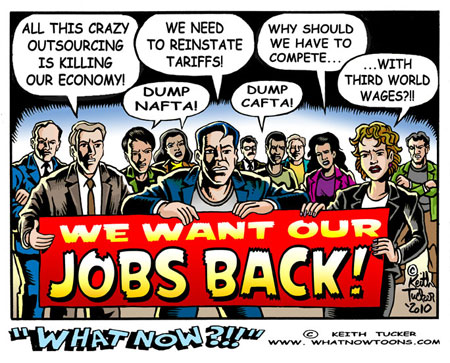
Letīs Do Some Economics
| Definition: A tariff is a tax imposed on imported goods |
When analysing the effects on stakeholders of imposing a tariff on imported goods it is best seen in a tariff diagram. So you are going to construct a tariff diagram - active economics - step by step.
1. Have ready an A4 sheet of paper, a pencil, pen and ruler - yes Joao a ruler (you can also have an eraser ready)
2.
Draw 2 axes for price and quantity, a supply and demand curve (make
this big and clear). label these Sdom and Ddom for domestic S and D
3. Draw your dotted lines and equilibrium price (Pe) and quantity(Qe) - before the tariff.
4. Draw a horizontal line well below the equilibrium to represent supply at the world price before the tariff - assuming that domestic consumers can buy as much from the world market at the world price as they want to without affecting the world price. Many countries supply goods compared with domestic demand, therefore perfectly elastic.
Now work out and indicate on your diagram:
(i) The equilibrium quantity (Sworld = Ddom)
(ii) Of that equilibrium quantity how much is produced by domestic producers
(iii) How much is therfore imported from the world market.
5. Impose a tariff (Sworld shifts upwards by the amount of the tax (tariff)) ie draw a horizontal line (Sworld+tariff) somewhere between Pworld and the equilibrium.
Now work out and indicate on your diagram:
(i) How much is the new equilibrium (Sworld+tariff = Ddom)
(ii) By how much have imports fallen?
(iv) By how much has domestic production risen?
(v) The amount collected in tax revenue for the government.
Given the stakeholders (domestic producers, foreign producers, consumers and the government) evaluate from this analysis who wins and who loses from the imposition of a tariff.
Look at what happens to Consumer and Producer surplus:
1. Have ready an A4 sheet of paper, a pencil, pen and ruler - yes Joao a ruler (you can also have an eraser ready)
2. Draw 2 axes for price and quantity, a supply and demand curve (make this big and clear). label these Sdom and Ddom for domestic S and D do not include equilibrium dotted lines etc
3. Draw a horizontal line well below the equilibrium to represent supply at the world price before the tariff
4. Outline in colour the amount of Consumer Surplus using the world price supply and domestic demand
5. Outline (different colour) domestic producer surplus
6. Impose a tariff (Sworld shifts upwards by the amount of the tax (tariff)) ie draw a horizontal line (Sworld+tariff) somewhere between Pworld and the equilibrium.
Now work out and indicate on your diagram:
(i) The change in consumer surplus
(ii) The change in domestic producer surplus
(iii) The government Revenue
Ok so far so good. Now identify the amount that was once consumer surplus and now is domestic producer surplus (it has been transferred from consumers to producers).
The rectangle that is now government revenue was also originally consumer surplus but is now transferred to the government.
Which
2 areas on your diagram were once consumer surplus but are now not yet
have not been transferred to another stakeholder? What shape are they?
Because these 2 areas were consumer surplus (benefit to consumers) and are now lost to consumers but are not transferred to other stakeholders they are a loss to the economy as a whole and are known as welfare (benefit) or deadweight loss.
Finally
can you unequivocally say (make a judgement) whether tariffs are a
benefit or not to an economy, taking into account their effects on
stakehoders?